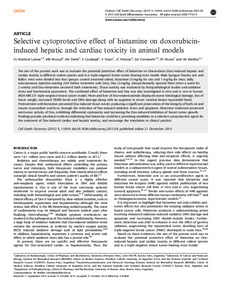Por favor, use este identificador para citar o enlazar este ítem:
https://repositorio.uca.edu.ar/handle/123456789/8706| Título: | Selective cytoprotective effect of histamine on doxorubicin-induced hepatic and cardiac toxicity in animal models | Autor: | Martinel Lamas, Diego J. Nicoud, Melisa Beatriz Sterle, Helena Andrea Carabajal, Eliana Tesan, Fiorella C. Perazzo, Juan C. Cremaschi, Graciela A. Rivera, Elena S. Medina, Vanina Araceli |
Palabras clave: | MEDICINA; CANCER; ONCOLOGIA; HISTAMINA; ANIMALES DE LABORATORIO; EXPERIMENTACION EN LABORATORIO | Fecha de publicación: | 2015 | Editorial: | Nature Research | Cita: | Martinel Lamas D et al. (2015) Selective cytoprotective effect of histamine on doxorubicin-induced hepatic and cardiac toxicity in animal models. Cell Death Discovery 1, 15059. doi:10.1038/cddiscovery.2015.59. Disponible en: https://repositorio.uca.edu.ar/handle/123456789/8706 | Resumen: | Abstract: The aim of the present work was to evaluate the potential protective effect of histamine on Doxorubicin (Dox)-induced hepatic and cardiac toxicity in different rodent species and in a triple-negative breast tumor-bearing mice model. Male Sprague Dawley rats and Balb/c mice were divided into four groups: control (received saline), histamine (5mg/kg for rats and 1mg/kg for mice, daily subcutaneous injection starting 24 h before treatment with Dox), Dox (2mg/kg, intraperitoneally injected three times a week for 2 weeks) and Dox+histamine (received both treatments). Tissue toxicity was evaluated by histopathological studies and oxidative stress and biochemical parameters. The combined effect of histamine and Dox was also investigated in vitro and in vivo in human MDA-MB-231 triple-negative breast cancer model. Heart and liver of Dox-treated animals displayed severe histological damage, loss of tissue weight, increased TBARS levels and DNA damage along with an augment in serum creatine kinase-myocardial band. Pretreatment with histamine prevented Dox-induced tissue events producing a significant preservation of the integrity of both rat and mouse myocardium and liver, through the reduction of Dox-induced oxidative stress and apoptosis. Histamine treatment preserved anti-tumor activity of Dox, exhibiting differential cytotoxicity and increasing the Dox-induced inhibition of breast tumor growth. Findings provide preclinical evidence indicating that histamine could be a promising candidate as a selective cytoprotective agent for the treatment of Dox-induced cardiac and hepatic toxicity, and encourage the translation to clinical practice. | URI: | https://repositorio.uca.edu.ar/handle/123456789/8706 | ISSN: | 2058-7716 | Disciplina: | MEDICINA | DOI: | 10.1038/cddiscovery.2015.59 | Derechos: | Acceso abierto | Fuente: | Cell Death Discovery vol. 1, 2015 |
| Aparece en las colecciones: | Artículos |
Ficheros en este ítem:
| Fichero | Descripción | Tamaño | Formato | |
|---|---|---|---|---|
| selective-cytoprotective-effect-histamine.pdf | 3,83 MB | Adobe PDF |  Visualizar/Abrir |
Visualizaciones de página(s)
284
comprobado en 15-dic-2025
Descarga(s)
200
comprobado en 15-dic-2025
Google ScholarTM
Ver en Google Scholar
Altmetric
Altmetric
Este ítem está sujeto a una Licencia Creative Commons

